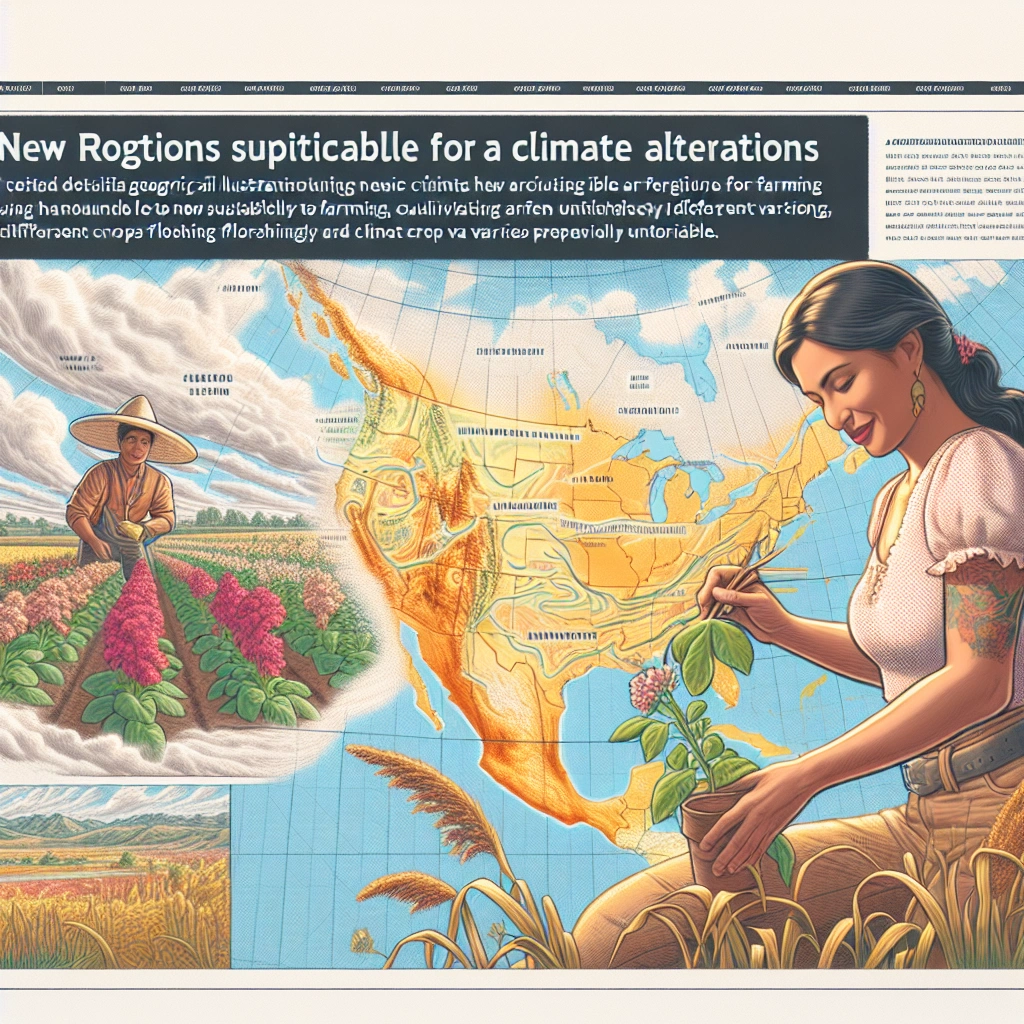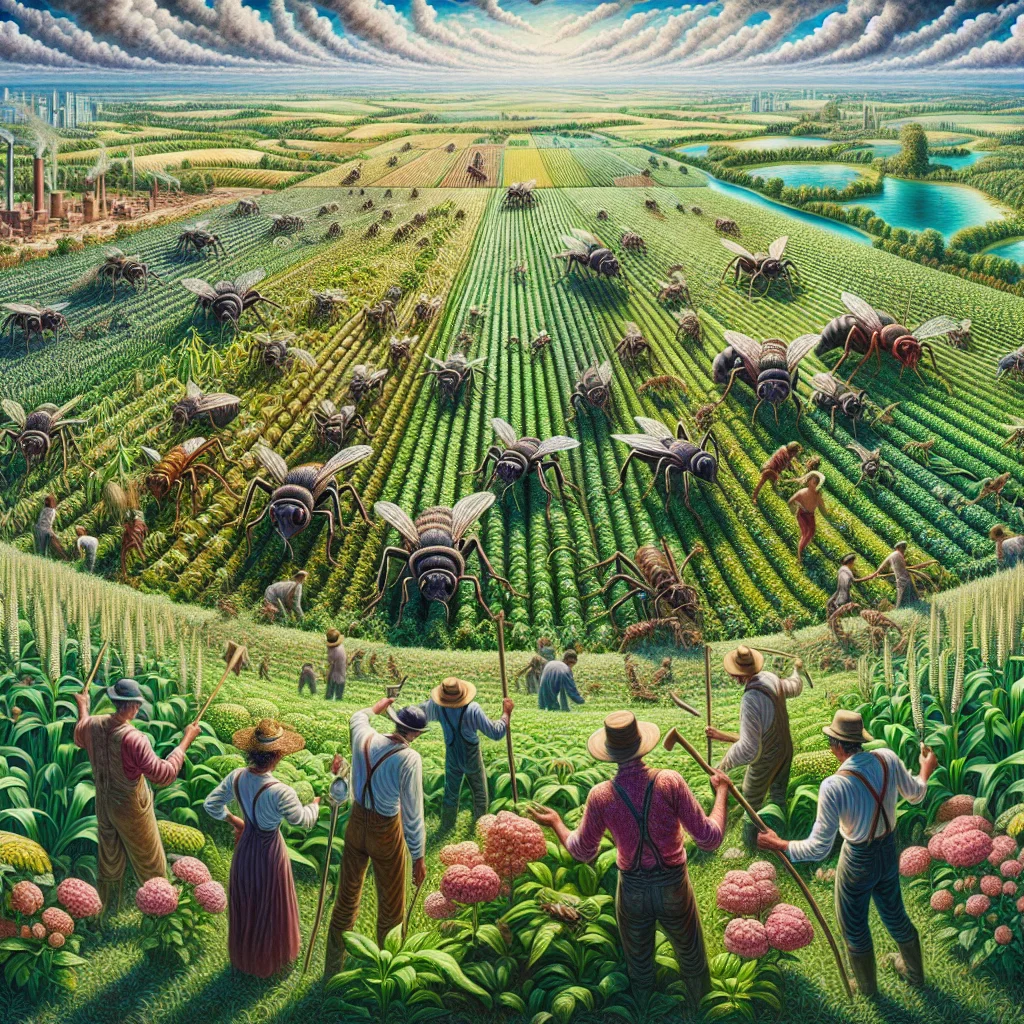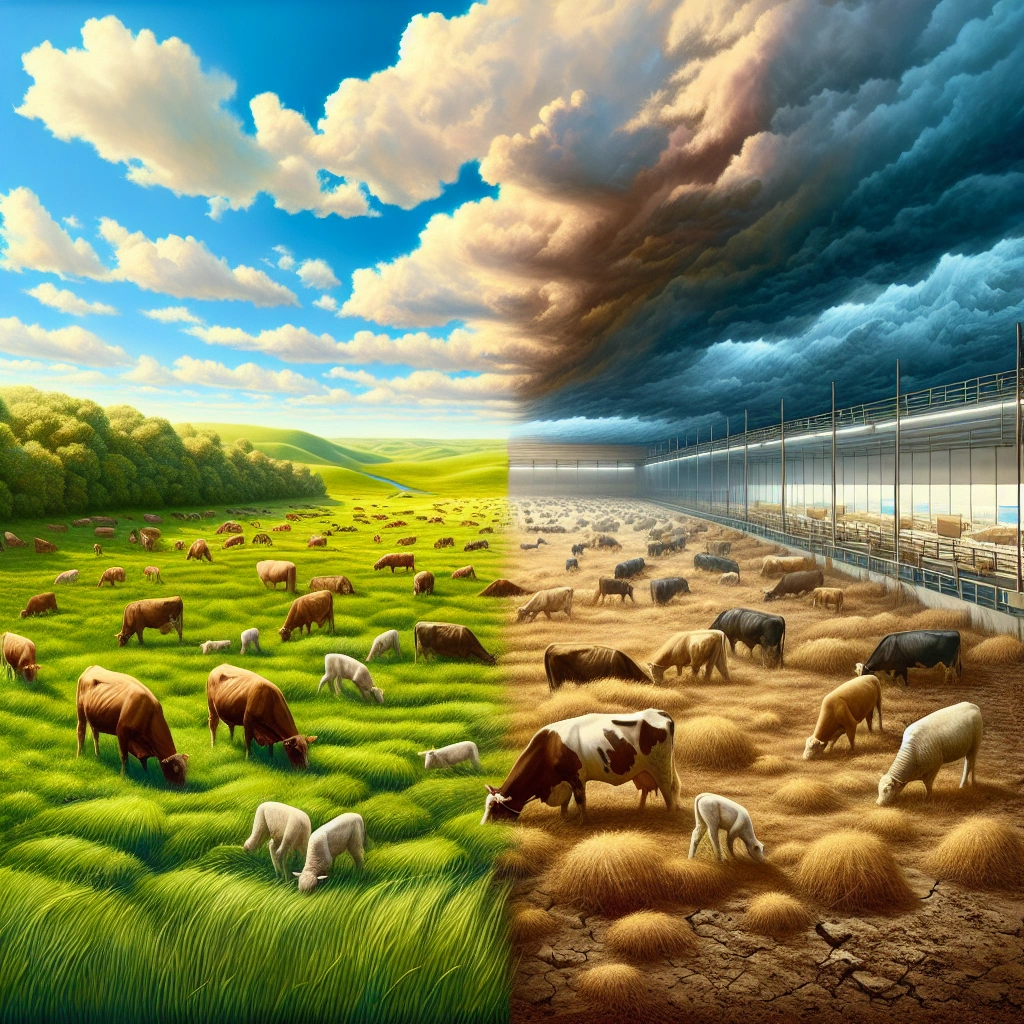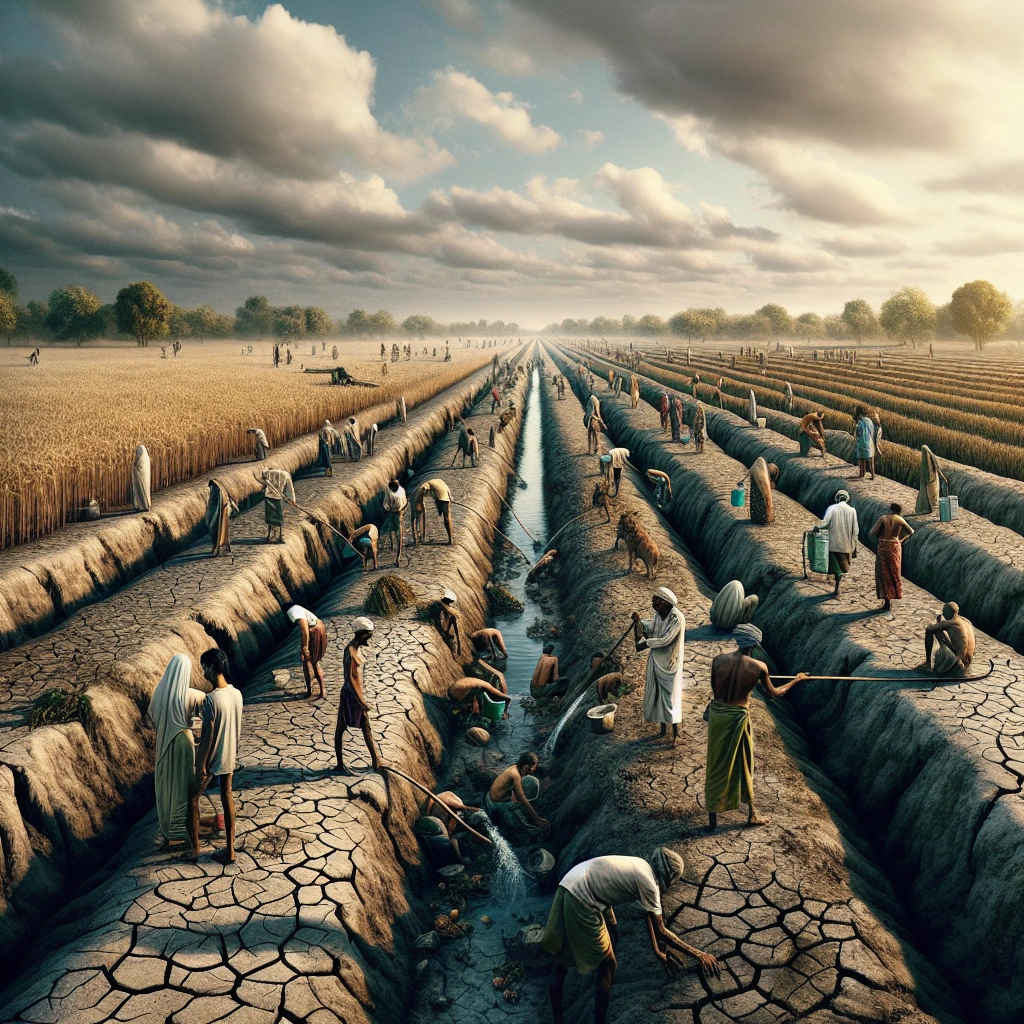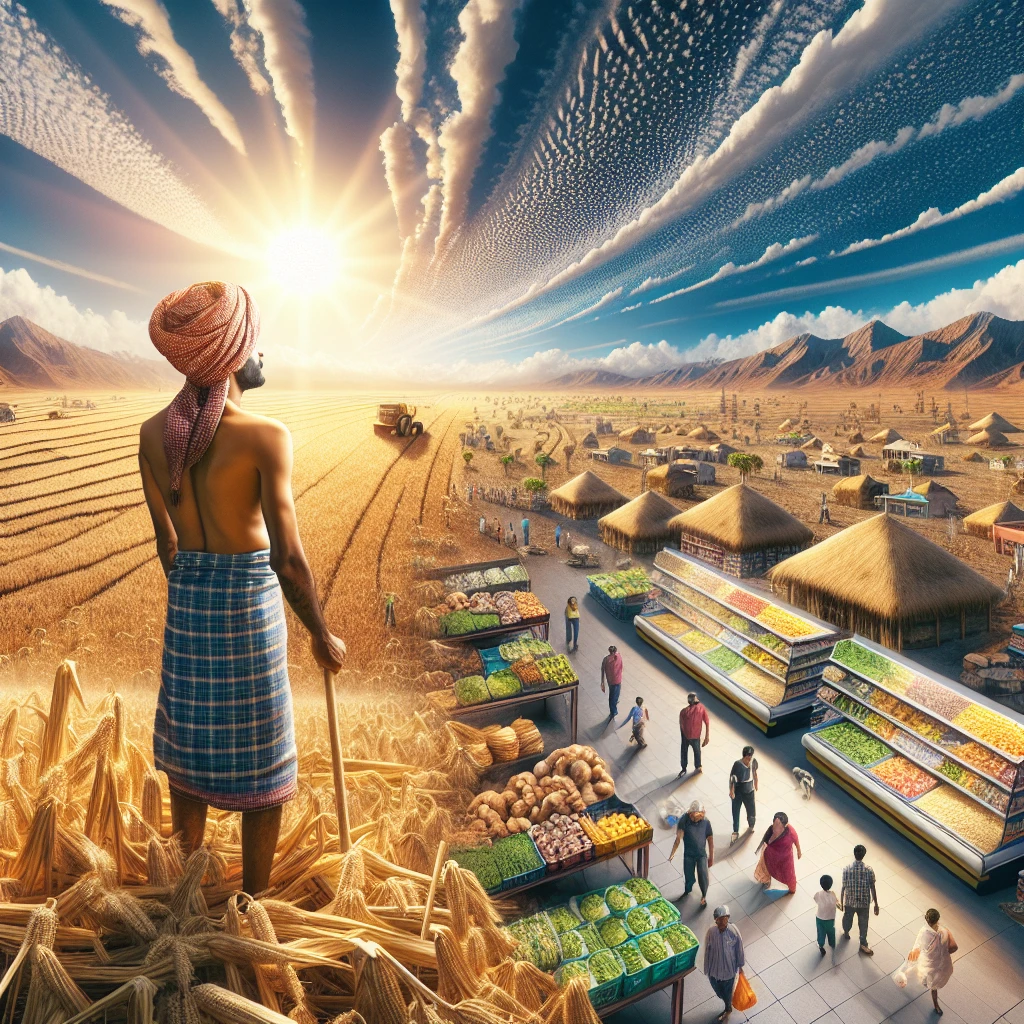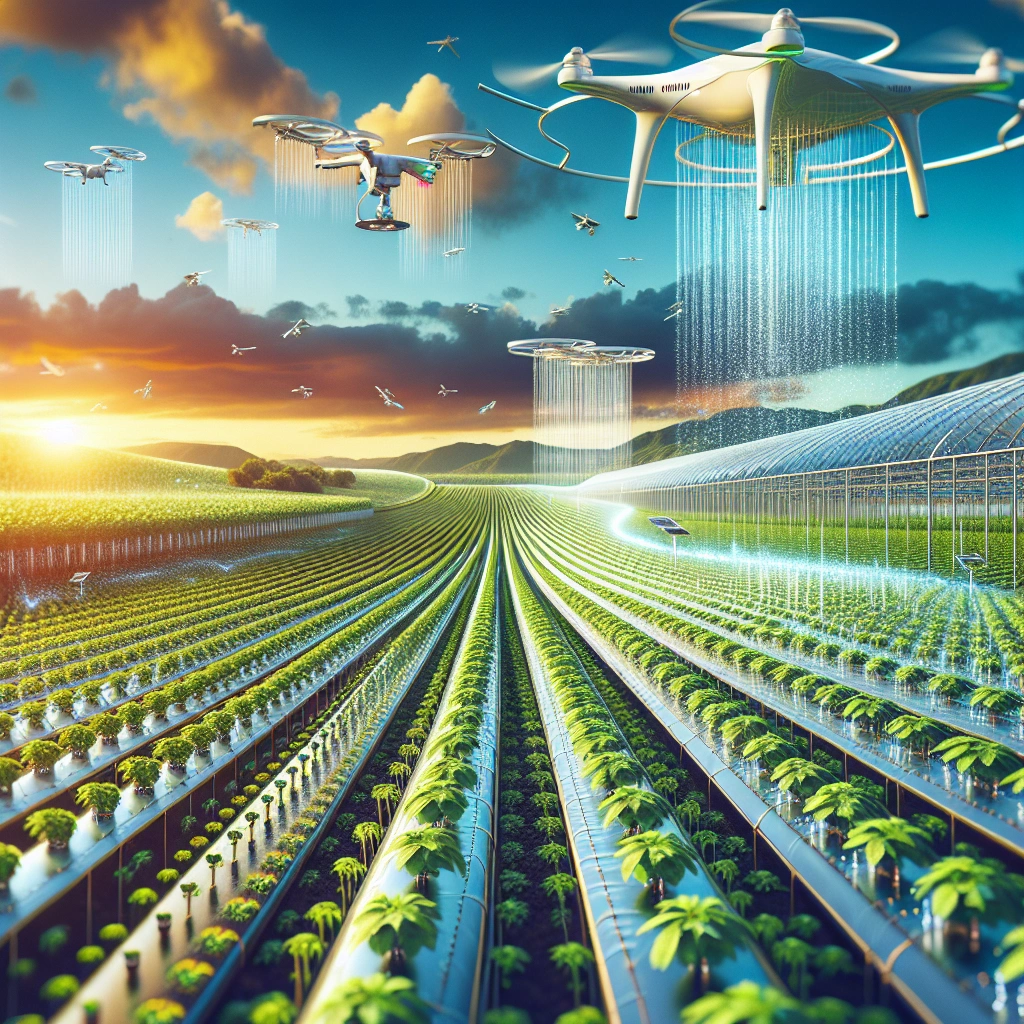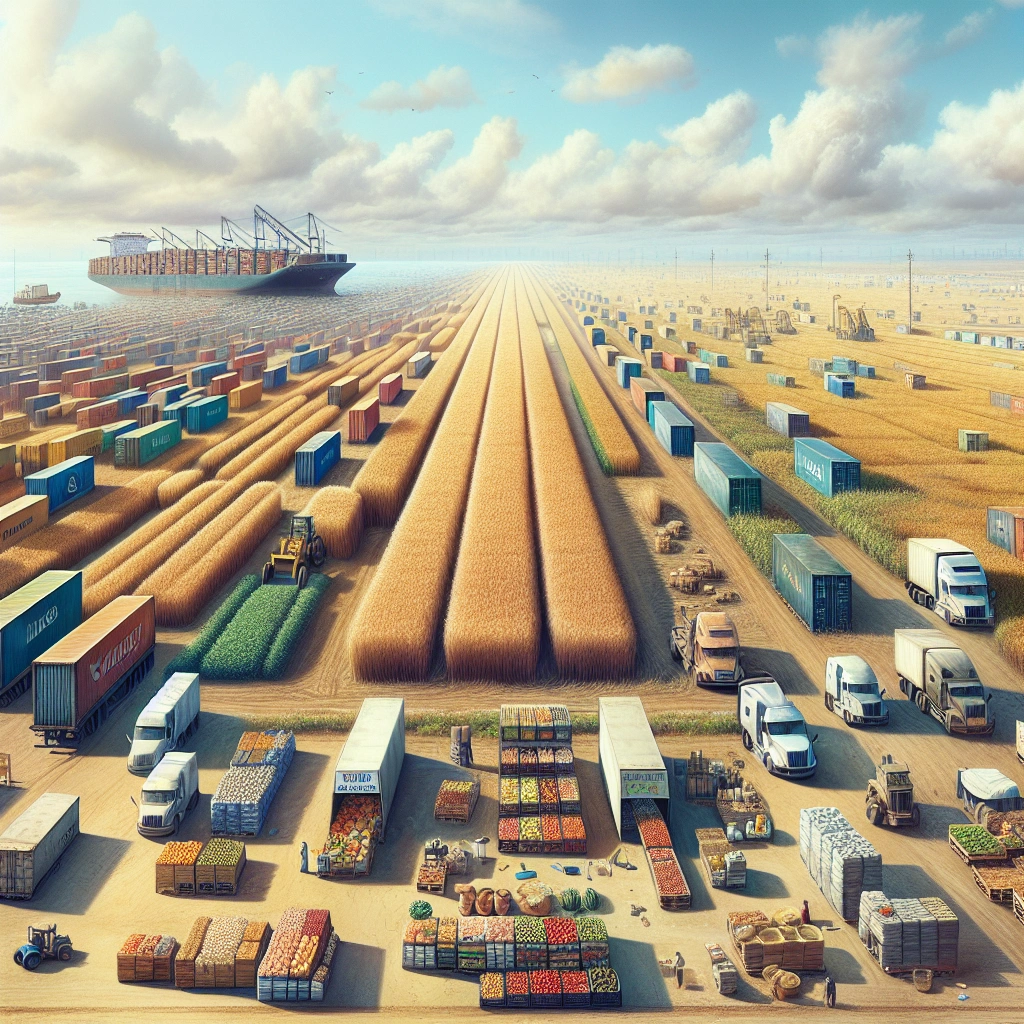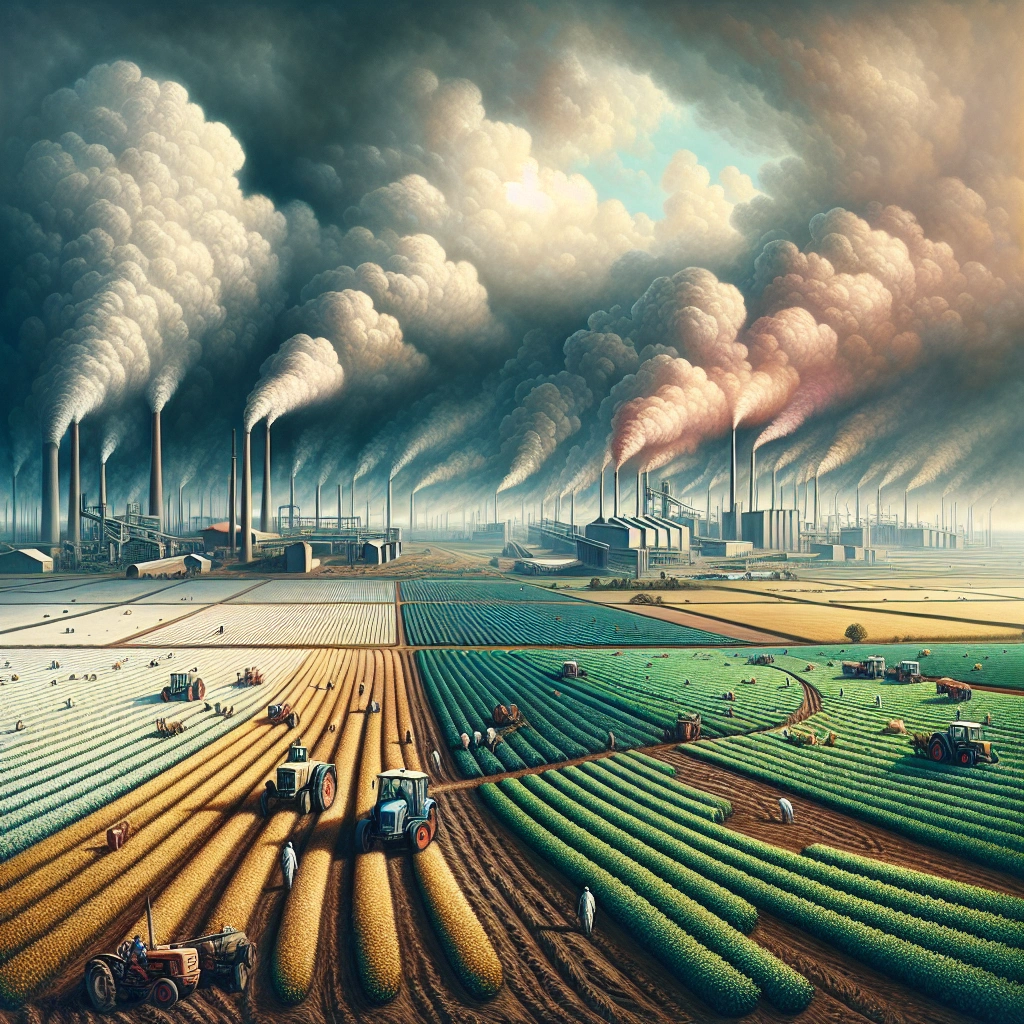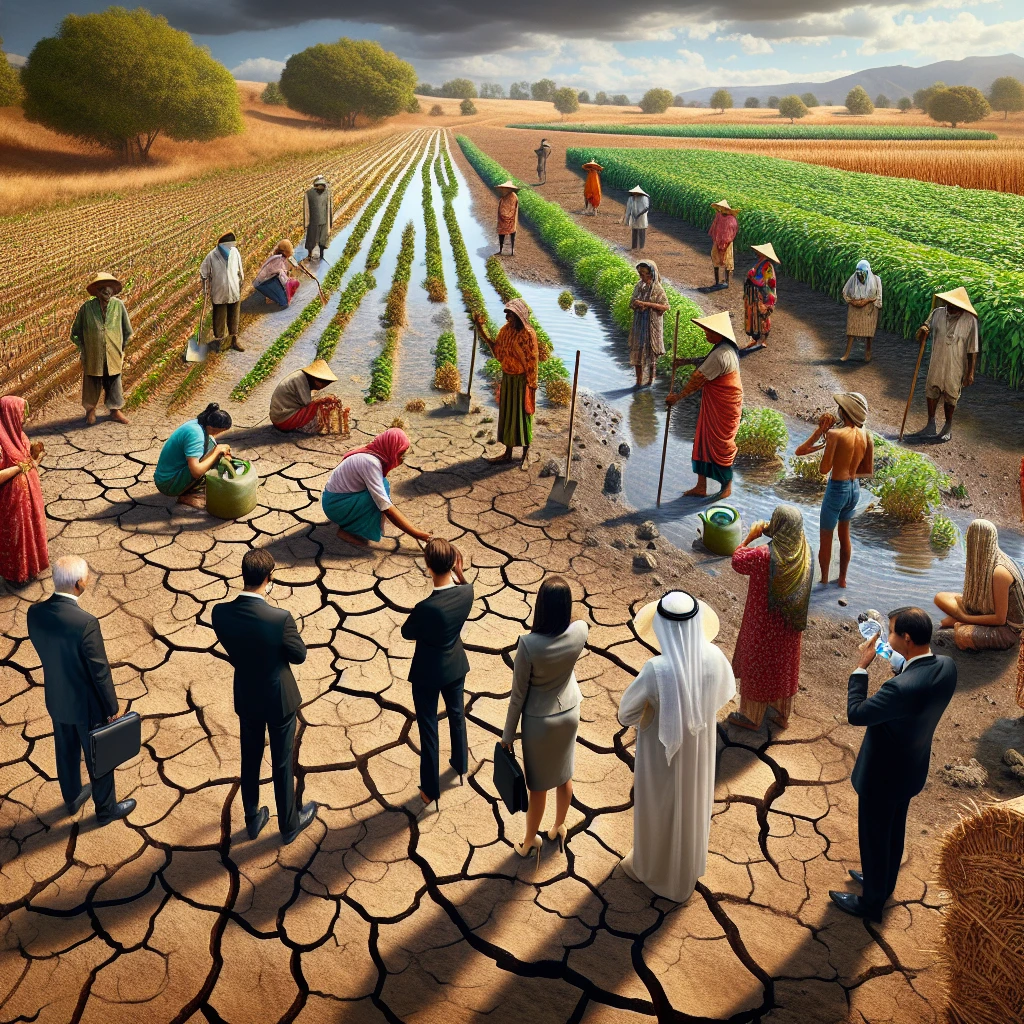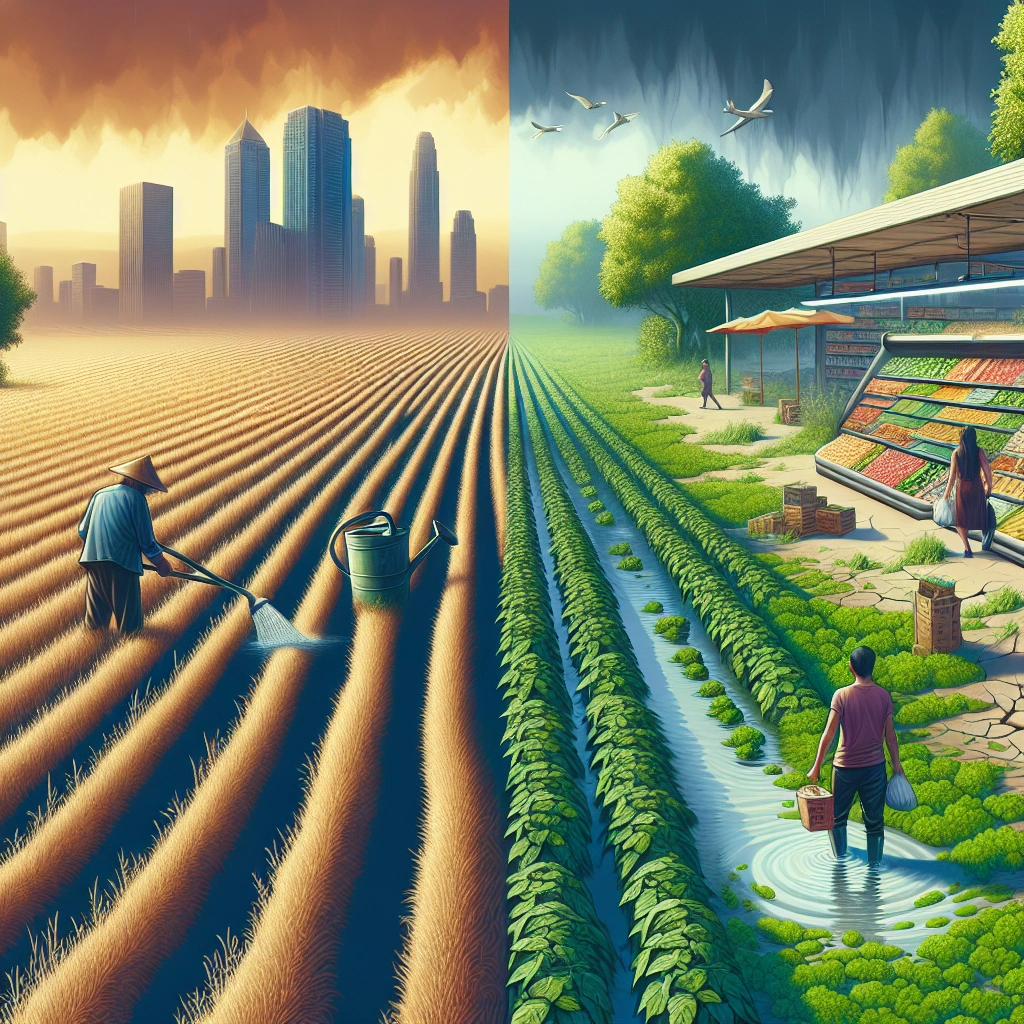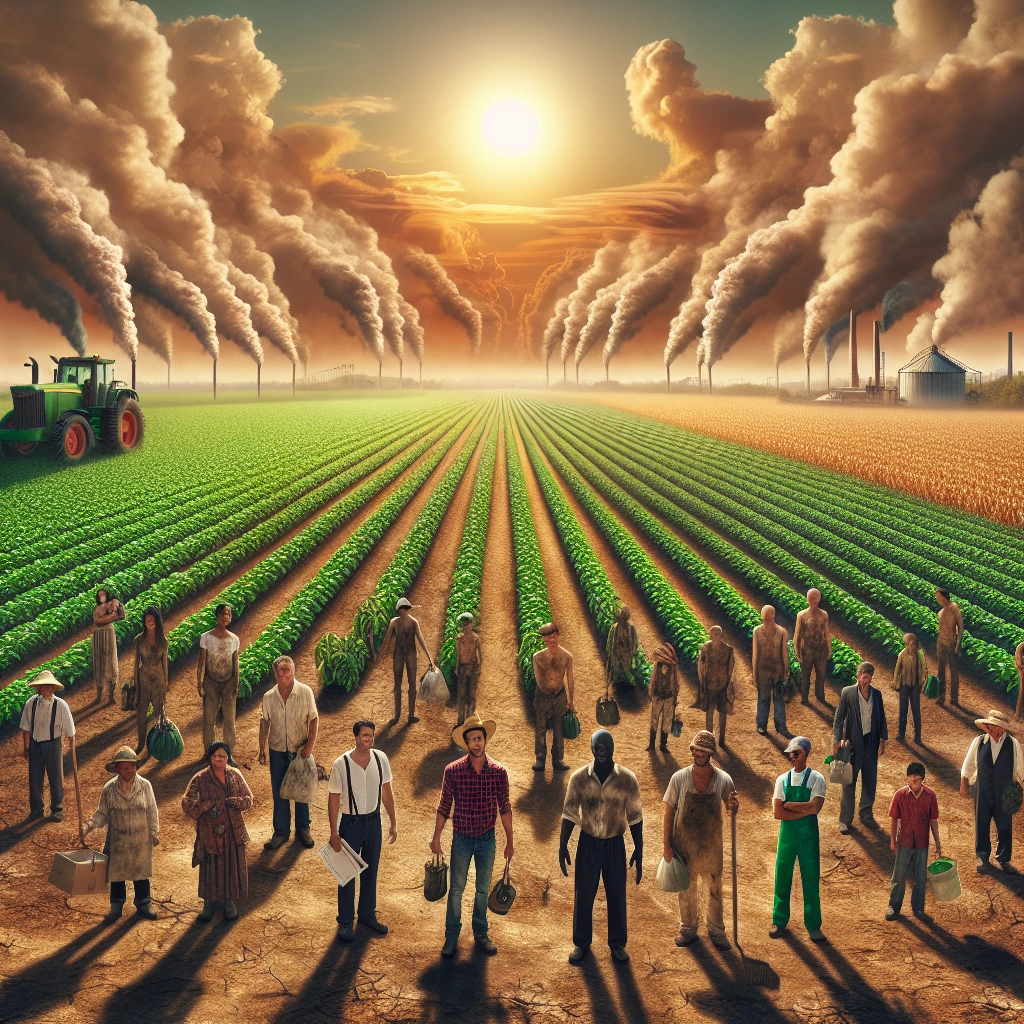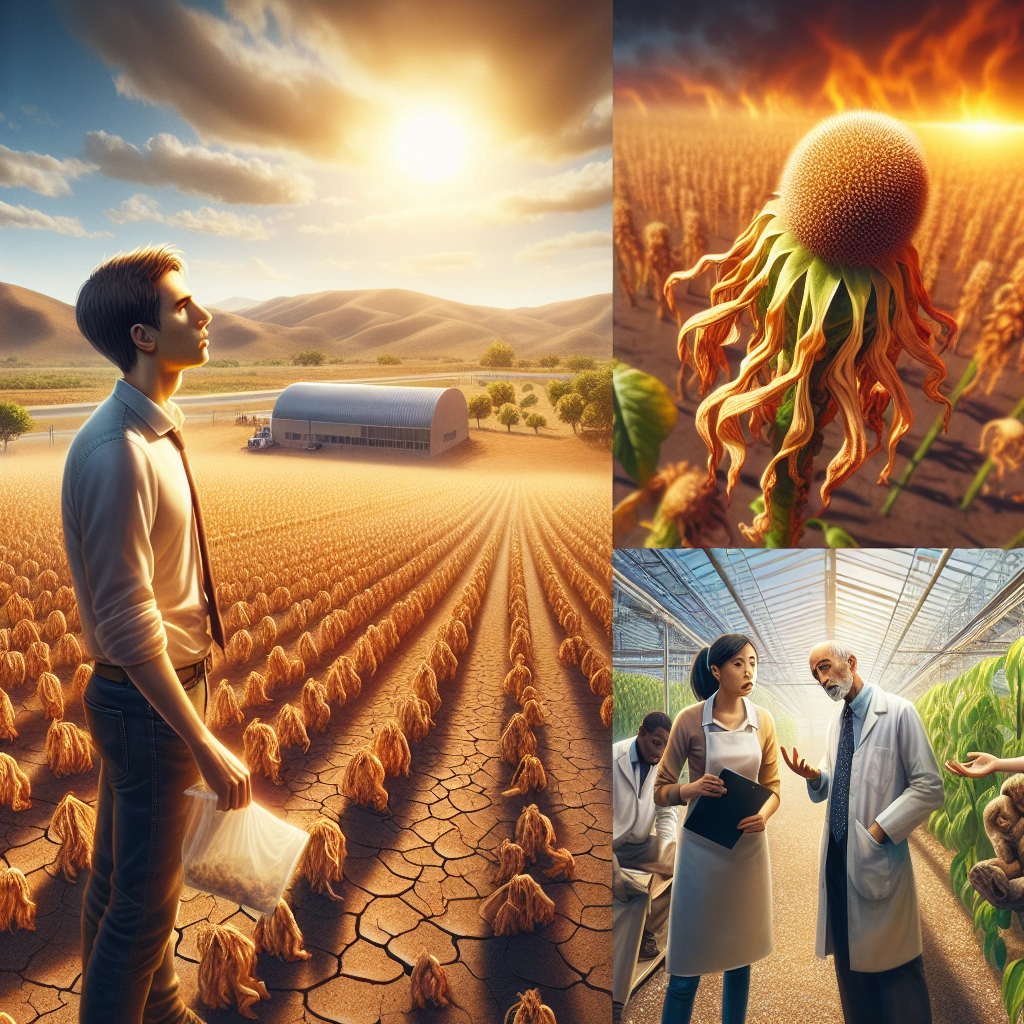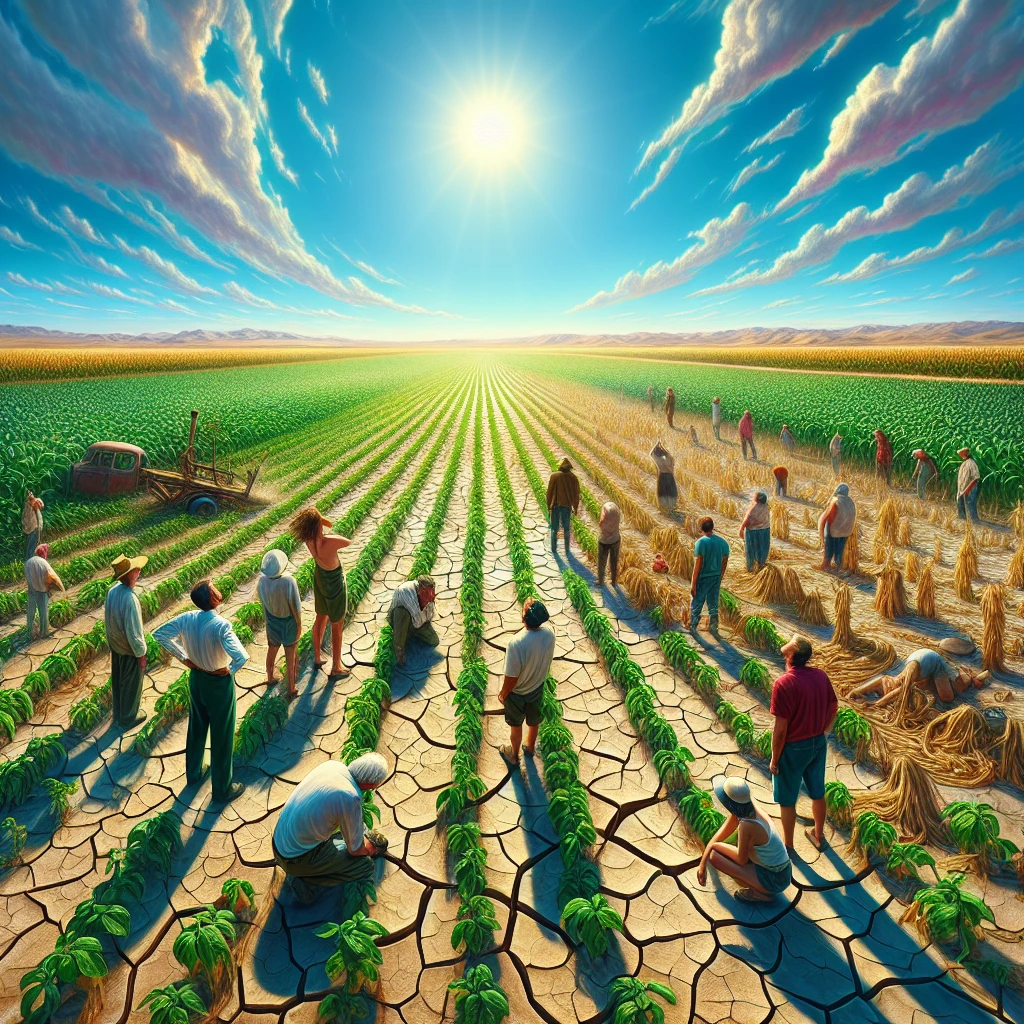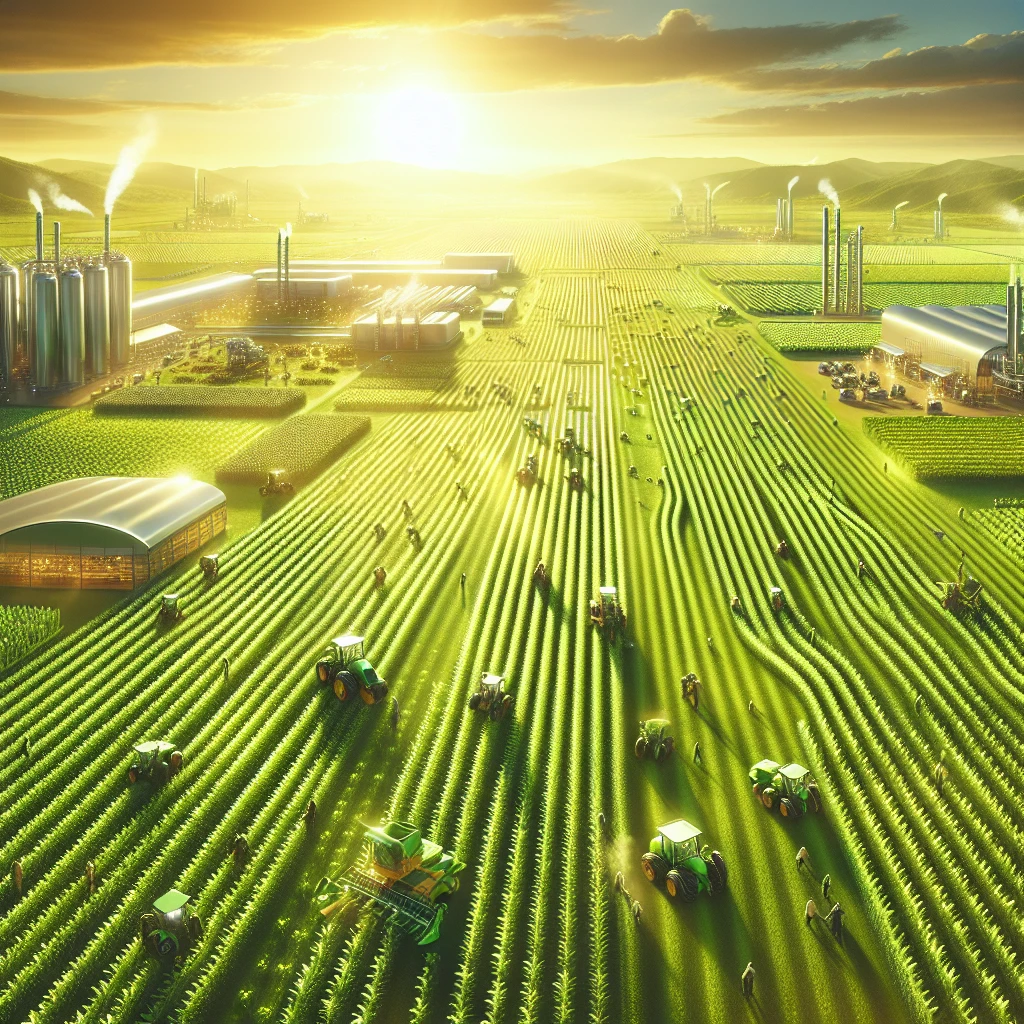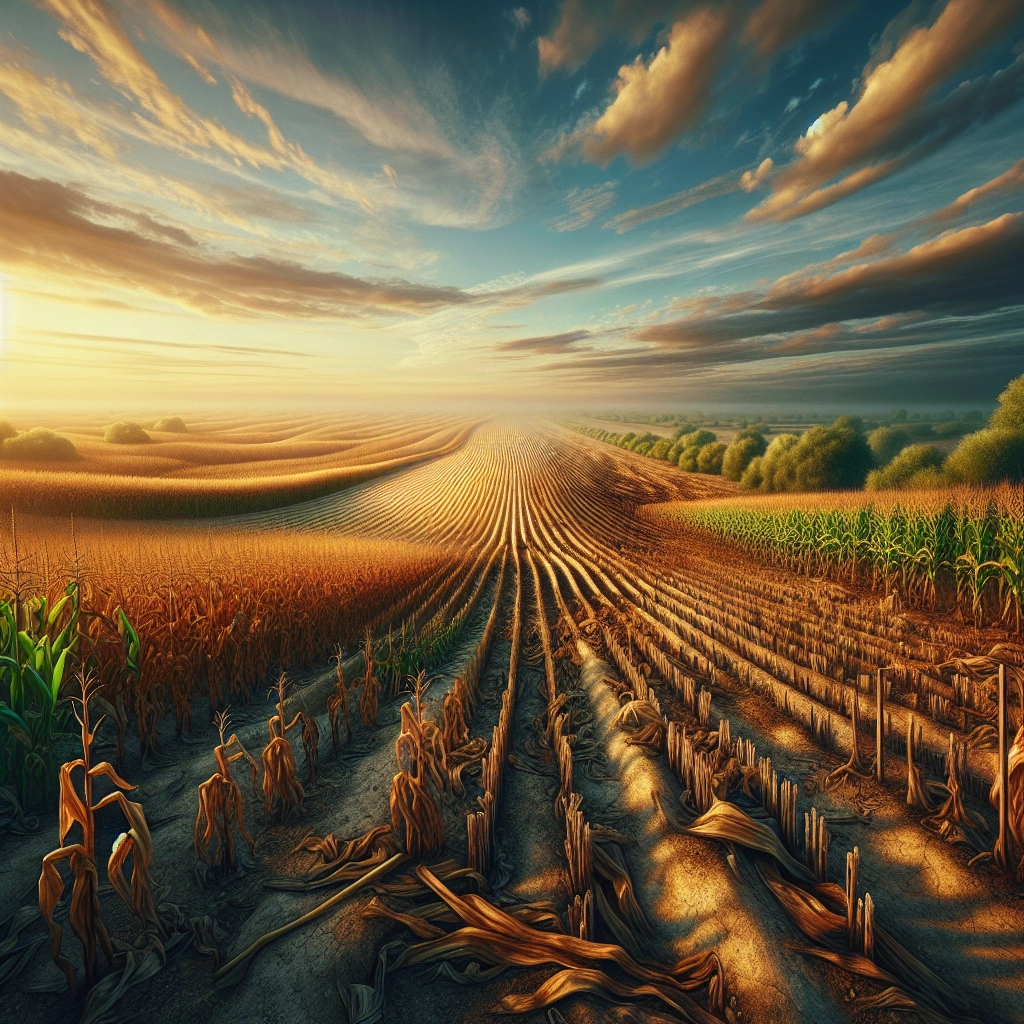

The projected effects of climate change on the food production industry include disruptions in agricultural productivity due to changes in temperature and rainfall patterns. This can lead to reduced food availability and access, as well as a potential decline in food quality.
Climate change can also impact crop yields and contribute to challenges in increasing yields, particularly in regions where higher temperatures intensify drought stress.
The changing climate can also affect the ranges and distribution of pests and weeds, leading to new problems for crop production. Insect dynamics may expand geographically, increase survival rates, and impact the relationships between pests, their environment, and other insect species.
As a result, up to 40% of global crop production is lost to plant pests and diseases, imposing significant economic costs on the food production industry. These projected effects of climate change highlight the need for adaptation and mitigation strategies to ensure a sustainable and resilient food production system.
Check out this Youtube video: “A Vision for Crop Improvement and Food Security…” to understand the projected effects of climate change on the food production industry and gain insights on how we can improve crop resilience in the face of environmental challenges.
Impact on Crop Yields
Climate change profoundly affects the quantity and quality of crop yields. Rising temperatures and changing precipitation patterns impact the growth and production of crops.
For instance, increased temperatures can lead to heat stress on plants, affecting their growth and yield. Additionally, fluctuations in precipitation patterns, such as irregular rainfall and droughts, can significantly reduce crop yields and food production.
Changes in temperature and precipitation patterns are crucial factors in determining crop yields. Shifts in temperature can disrupt the delicate balance necessary for optimal plant growth.
Moreover, alterations in precipitation patterns can lead to water stress, negatively impacting crop health and productivity. For example, insufficient rainfall can hinder crop growth, leading to yield reductions.
Extreme weather events play a pivotal role in impacting crop production. Events like floods, storms, and prolonged droughts can devastate agricultural fields, leading to substantial reductions in crop yields.
For instance, excessive rainfall from storms can cause flooding, leading to waterlogged soil and crop damage, while prolonged droughts can result in water scarcity, impacting crop growth negatively.
Shifts in Agricultural Zones
Climate change has been causing significant shifts in agricultural zones worldwide. As temperatures rise, high latitude regions are experiencing warming, leading to a northward shift of the agricultural climate zone.
This shift is impacting the types of crops that can be grown in different regions, as the traditional zones for specific crops are being altered by changing climate patterns. Farmers are now facing the challenge of adapting to these new agricultural zones, requiring adjustments in crop selection and agricultural practices to thrive in the changing environment.
How climate change leads to shifts in agricultural zones
The primary driver of shifts in agricultural zones is the rising global temperatures caused by climate change. This has resulted in a warming trend in high latitude regions, pushing the boundaries of traditional agricultural zones further north.
As a result, regions that were previously unsuitable for certain crops are now becoming viable for cultivation, while areas that were once ideal for specific crops may no longer be conducive to their growth.
Impact on the types of crops that can be grown in different regions
The impact on the types of crops that can be grown in different regions is substantial. With the northward shift of agricultural zones, certain crops that were traditionally grown in specific areas may no longer be feasible, while new opportunities are arising for the cultivation of different crops in these regions.
This shift is challenging the established norms of crop suitability and requiring farmers to reassess their planting choices based on the evolving climate conditions.
Challenges and opportunities for farmers in adapting to new agricultural zones
Farmers are facing both challenges and opportunities in adapting to the new agricultural zones. The challenges include the need to adjust to unfamiliar growing conditions, potential changes in pest and disease patterns, and the reevaluation of crop selection to align with the shifting zones.
On the other hand, this shift presents opportunities for farmers to explore new crop varieties that may thrive in the evolving climate, potentially leading to increased diversification and resilience in the agricultural industry.
| Challenges for Farmers | Opportunities for Farmers |
|---|---|
| Adjusting to unfamiliar growing conditions | Exploration of new crop varieties |
| Potential changes in pest and disease patterns | Increased diversification of crops |
| Reevaluation of crop selection | Enhanced resilience in the agricultural industry |
Changes in Pest and Disease Patterns
The projected effects of climate change on pest and disease patterns in the food production industry
Climate change is expected to impact pest and disease patterns in the food production industry by altering the geographical distribution and population dynamics of various pests. Warmer temperatures and changing precipitation patterns can create more favorable conditions for the proliferation of pests, leading to increased infestations and outbreaks.
Increased risks of crop damage and yield losses
As a result of these changing pest and disease patterns, there is an increased risk of crop damage and yield losses in the food production industry. Pests and diseases can cause significant harm to crops, leading to reduced productivity and economic losses for farmers.
This poses a threat to global food security and agricultural sustainability.
Potential strategies for mitigating the impact of changing pest and disease patterns
To mitigate the impact of changing pest and disease patterns, adaptive agricultural practices and integrated pest management strategies are crucial. Implementing sustainable farming techniques, utilizing advanced technologies, and promoting biodiversity can help control pest populations and minimize crop damage.
Additionally, investing in research and development for pest-resistant crop varieties and effective biocontrol methods is essential to safeguarding future food production.
Water Availability and Irrigation
How climate change affects water availability for irrigation in agricultural practices
Climate change has a significant impact on water availability for irrigation in agricultural practices. Changes in temperature and precipitation patterns can lead to variations in the availability of water for irrigation.
As temperatures rise and rainfall patterns shift, the demand for water in agriculture increases, leading to potential water scarcity for irrigation purposes. This can result in a reduction in crop yield and quality, affecting the overall food production industry.
Impacts on water sources for farming
The impacts of climate change on water sources for farming are profound. Fluctuations in precipitation and surface water supplies, alongside the reduction of snow packs and glaciers, directly affect water availability for farming.
This ultimately disrupts agricultural practices and poses challenges for sustainable food production. The changing water sources influence the accessibility and reliability of water for irrigation, which directly impacts the ability to cultivate essential crops.
Innovative irrigation techniques and technologies to address water scarcity
In response to water scarcity caused by climate change, innovative irrigation techniques and technologies have emerged to address these challenges. Smart irrigation approaches, such as precision agriculture, drip irrigation, and artificial intelligence-driven systems, optimize water usage and enhance efficiency.
Additionally, unconventional methods, like fog-catching and iceberg harvesting, offer alternative ways to mitigate water scarcity. These innovations play a crucial role in ensuring sustainable water management and food production in the face of climate change.
| Innovative Irrigation Techniques | Description |
|---|---|
| Precision Agriculture | Utilizes data-driven technologies to apply water and nutrients precisely, reducing waste and optimizing resource utilization. |
| Drip Irrigation | Delivers water directly to the plant roots, minimizing evaporation and water loss, thereby conserving water resources. |
| Artificial Intelligence-driven Systems | Leverages AI to monitor and adjust irrigation in real time, ensuring optimal water distribution based on crop needs. |
| Fog-catching and Iceberg Harvesting | Utilizes unconventional methods to capture and utilize water resources, offering alternative solutions to combat water scarcity. |
Effects on Livestock Production
The impact of climate change on the livestock industry is substantial, with heat stress, reduced feed quality and availability, diseases, and increased mortality rates due to extreme weather events like storms and floods. These factors directly threaten livestock well-being and productivity, leading to significant challenges for the industry.
Changes in animal health and productivity are pronounced due to climate change. Livestock growth rates, reproductive performance, morbidity, and mortality are all influenced, demonstrating how climate shifts can detrimentally affect the overall health and productivity of the animals.
Adaptation strategies for sustainable livestock production in a changing climate are crucial for the industry’s resilience. These strategies may include promoting locally adapted animal breeds, investing in infrastructure for water availability, improving animal health, and integrating livestock systems to mitigate the impact of climate change on livestock production.
| Adaptation Strategies |
|---|
| Promotion of locally adapted animal breeds |
| Investment in infrastructure for water availability |
| Improvement of animal health |
| Integration of livestock systems for mitigating climate change impacts |
These strategies are essential for sustaining livestock production amid the challenges posed by climate change. By embracing these adaptive measures, the industry can enhance its resilience to the shifting climate patterns and ensure sustainable production in the face of adversity.
Food Security and Access
How climate change affects food security and access
Climate change significantly impacts food security and access by disrupting food availability, reducing access to food, and increasing food prices, thereby affecting people’s ability to obtain nutritious meals. It leads to extreme weather events, diminished water supplies, heat stress, and a surge in pests and diseases, adversely impacting agricultural production.
For instance, rising temperatures can lead to changes in crop yields and patterns, affecting the quantity and variety of available food. Additionally, unpredictable weather patterns can lead to the destruction of crops, causing food shortages and price spikes.
Vulnerable populations and communities at risk
Vulnerable populations and communities, particularly in Sub-Saharan Africa, South Asia, and Southeast Asia, face heightened risks due to climate impacts on food security. Approximately 80% of the global population at risk of hunger and crop failures are in these regions.
Moreover, the precarious situation is exacerbated in northern and Indigenous communities in countries like Canada, where climate change has a direct impact on food security. These communities face challenges in accessing nutritious food, further intensifying their vulnerability.
Policy and intervention measures to address food security challenges in the face of climate change
To address the challenges posed by climate change on food security, numerous policy and intervention measures are crucial. Implementing sustainable agricultural practices, investing in climate-resilient crop varieties, and improving water management systems are imperative.
Furthermore, enhancing social protection, promoting efficient food distribution systems, and supporting innovative policy approaches can help mitigate the impact of climate change on food security. These measures are essential for bolstering food security and ensuring resilience in the face of climate change.
| Climate Change Effects | Responsible Action |
|---|---|
| Disruption of Food Availability | Adoption of Sustainable Agricultural Practices |
| Reduced Access to Nutritious Food | Investment in Climate-Resilient Crop Varieties |
| Price Spikes and Food Shortages | Improvement of Water Management Systems |
| Impact on Vulnerable Communities | Enhanced Social Protection and Support |
These initiatives, coupled with global cooperation and long-term strategies, are paramount in safeguarding food security amidst the challenges posed by climate change. Promoting sustainable practices and fostering resilience is essential for ensuring access to adequate and nutritious food for all, especially for the most vulnerable communities.
Economic Impacts
The projected economic impacts of climate change on the food production industry
Projected climate change effects on the food production industry can include decreased agricultural productivity due to temperature increases, changes in precipitation patterns, extreme weather events, and reduced water availability. These impacts may disrupt food availability, reduce access to food, and compromise food quality, leading to significant economic repercussions for the industry.
Costs and benefits of adaptation and mitigation strategies
Adaptation strategies, such as crop diversification and water conservation, entail initial costs but offer long-term benefits by safeguarding agricultural output. Mitigation measures, including sustainable farming practices and renewable energy adoption, can mitigate climate change impacts, reducing economic losses and enhancing industry resilience.
Long-term consequences for the global economy
The long-term consequences of climate change on the food production industry can reverberate throughout the global economy, affecting food security, trade dynamics, and market prices. Additionally, adaptation and mitigation strategies can yield positive economic outcomes, contributing to sustainable development and global economic stability.
Technology and Innovation
Role of technology and innovation in mitigating the effects of climate change on food production
Technology and innovation play a pivotal role in mitigating the impact of climate change on food production. For example, precision agriculture employs advanced technologies such as drones, GPS, and data analytics to optimize resource usage and enhance crop yields, ultimately offsetting the effects of an unpredictable climate.
Furthermore, innovative automation technologies streamline farming processes, reducing labor costs and increasing efficiency in adverse weather conditions. These advancements demonstrate the transformative power of technology in safeguarding global food security amidst changing climate patterns.
Advances in agricultural practices, genetic engineering, and sustainable farming methods
In response to climate change, agricultural practices have evolved significantly, incorporating genetic engineering to develop resilient crops capable of withstanding extreme weather events. For example, genetic modifications have led to the creation of drought-resistant crops, offering improved adaptability to erratic precipitation patterns.
Moreover, sustainable farming encompasses techniques like agroforestry and crop rotation, promoting soil health and reducing the environmental impact of food production. These innovative approaches are fundamental in ensuring a stable food supply chain in the face of climate-related disruptions.
Opportunities for technological solutions to address climate-related challenges
Technology presents numerous opportunities to address and overcome climate-related challenges in the food production industry. For instance, advancements in digital agriculture enable real-time monitoring of environmental conditions, empowering farmers to make data-driven decisions and adapt to changing climates swiftly.
Additionally, the integration of biotechnology offers the potential to develop climate-resilient crop varieties that thrive in diverse environmental conditions, ultimately fortifying global food systems against the repercussions of climate change.
| Technological Solutions | Benefits |
|---|---|
| Precision Agriculture | Optimized resource usage and improved crop yields |
| Genetic Engineering | Development of resilient, climate-adaptive crops |
| Sustainable Farming | Reducing environmental impact and promoting soil health |
| Digital Agriculture | Real-time monitoring for data-driven decision-making |
| Biotechnology Integration | Creation of climate-resilient crop varieties |
The intersection of technology and innovation presents a formidable arsenal against the projected effects of climate change on food production. Implementing these advancements in agricultural practices and food production methods is crucial in safeguarding global food security in the face of a rapidly changing climate.
International Trade and Supply Chains
Impact of climate change on international trade and global food supply chains
Climate change has a significant impact on international trade and global food supply chains. Extreme weather events disrupt supply chains, damage transport infrastructure, and restrict people’s ability to travel, thereby affecting the global movement of food products.
Additionally, ocean warming and acidification due to climate change negatively impact fisheries, leading to a reduction in trade of ocean products and food security. These impacts directly affect the livelihoods of small-scale fishers and individuals involved in food supply chains, causing a ripple effect throughout the international trade network.
Factors influencing patterns of food production and distribution
Various factors influence the patterns of food production and distribution, including technological advancements, market forces, and consumer preferences. However, climate change plays a crucial role in shaping these patterns.
Changing climatic conditions affect agricultural productivity, water availability, and soil quality, consequently impacting the global distribution of food. Additionally, food imports are influenced by cultivated land endowments, international food prices, technological progress, and food stocks, all of which are significantly impacted by climate-related factors.
Implications for food security and economic development in different regions
The implications of climate change on food security and economic development are varied across different regions. Extreme weather and shifting climatic conditions disrupt food availability, reduce access to nutritious food, and contribute to economic instability, particularly in regions reliant on agriculture and trade.
In addition, the complex global food trade network experiences increased instability and efficiency challenges due to climate change, ultimately affecting the economic development and food security of various regions globally.
| Factors | Influence |
|---|---|
| Technological Advancements | Impact productivity |
| Market Forces | Affect distribution |
| Consumer Preferences | Shape food patterns |
| Cultivated Land Endowments | Determine food imports |
| International Food Prices | Impact trade decisions |
Climate change has profound implications for international trade and global food supply chains, influencing factors such as food production patterns, distribution, and economic development. As we continue to witness the impact of climate change, it’s crucial to address these challenges and work towards creating sustainable and resilient food supply chains on a global scale.
Carbon Footprint and Emissions
How the food production industry contributes to greenhouse gas emissions
The food production industry significantly contributes to greenhouse gas emissions through various processes. For instance, livestock production generates substantial methane emissions due to the digestive processes of animals.
Additionally, crop production and food transportation also contribute to carbon dioxide emissions, with food waste being a considerable source of environmental impact.
Potential strategies for reducing the carbon footprint of food production
To mitigate the carbon footprint of food production, various strategies can be implemented. Sustainable sourcing, waste reduction, adoption of carbon-neutral technologies, and energy conservation are effective approaches.
Additionally, prioritizing fresh produce over processed foods and embracing regenerative agriculture can further contribute to reducing emissions.
Impact of climate change on efforts to mitigate emissions from the industry
The impact of climate change poses challenges to mitigating emissions from the food production industry. Shifts in temperatures and weather patterns can affect crop yields, livestock, and water resources, influencing the industry’s ability to reduce its carbon footprint.
Moreover, the need for resilience and adaptation becomes crucial in the face of changing climatic conditions.
| Strategies for Reducing Carbon Footprint |
|---|
| 1. Sustainable Sourcing |
| 2. Waste Reduction |
| 3. Carbon-Neutral Technologies |
| 4. Energy Conservation |
Policy and Regulatory Responses
Role of government policies and regulations in addressing the projected effects of climate change on the food production industry
The role of government policies and regulations in addressing the projected effects of climate change on the food production industry is crucial. Governments can implement policies that promote sustainable agricultural practices, such as organic farming and reduced pesticide usage, to mitigate the impact of climate change on food production.
By enforcing regulations that incentivize the use of renewable energy in farming and provide grants for climate-resilient crop research, governments can help the industry adapt to changing environmental conditions.
International agreements and initiatives to promote sustainable agriculture
International agreements and initiatives play a pivotal role in promoting sustainable agriculture. Collaborative efforts between countries can lead to the development of standardized environmental regulations for the food production industry, ensuring that practices align with global sustainability goals.
Initiatives like the United Nations’ Sustainable Development Goals encourage worldwide action to combat climate change and promote sustainable agricultural practices, providing a framework for international cooperation in addressing the projected effects of climate change on the food production industry.
Challenges and opportunities for effective policy responses
The challenges and opportunities for effective policy responses in addressing the projected effects of climate change on the food production industry are multifaceted. One challenge is the need for consistent enforcement of policies across different regions to ensure uniform progress towards sustainable agriculture.
However, this presents an opportunity for knowledge sharing between countries to identify best practices and facilitate the adoption of effective policies. Additionally, the integration of climate change adaptation strategies into agricultural policies presents an opportunity to build resilience within the food production industry.
This could involve initiatives such as crop diversification and investment in climate-smart technologies.
| Challenges | Opportunities |
|---|---|
| Consistent enforcement of policies across regions | Knowledge sharing for best practices |
| Integration of climate change adaptation strategies | Building resilience through crop diversification and climate-smart technologies |
Proactive government policies, international collaborations, and innovative strategies can collectively address the projected effects of climate change on the food production industry, ensuring a sustainable and resilient agricultural sector in the face of environmental challenges.
The Role of Consumer Behavior
Impact of consumer choices and behavior on the food production industry in the context of climate change
Consumer choices and behavior have a substantial impact on the food production industry in the context of climate change. As consumers become more conscious of the environmental impact of their food choices, there is a growing demand for sustainable and climate-resilient food products.
This shift in consumer behavior is prompting food producers to adapt their practices and offerings to align with these preferences.
Shifts in demand for sustainable and climate-resilient food products
There is a notable shift in consumer demand towards sustainable and climate-resilient food products. Consumers are seeking out environmentally friendly options and are willing to support brands and businesses that prioritize sustainability in their food production processes.
This has led to an increase in the availability and variety of eco-conscious food products in the market.
Potential for consumer-driven changes in the industry
Consumer-driven changes have the potential to catalyze significant transformations in the food production industry. With consumers advocating for sustainable practices and expressing their preferences through their purchasing decisions, food producers are compelled to innovate and adopt more environmentally friendly approaches.
This consumer-led momentum has the power to drive lasting changes in the industry.
| Pros | Cons |
|---|---|
| Consumer-driven changes promote sustainability | Increased production costs |
| Encourages innovation in food production | Supply chain adjustments required |
| Influences industry standards and practices | Consumer education and awareness needed |
Consumer choices and behavior play a pivotal role in shaping the food production industry in response to climate change. The demand for sustainable and climate-resilient food products reflects a growing consumer consciousness and provides a powerful impetus for positive change within the industry.
Remember, consumer-driven changes hold tremendous potential to steer the food production industry towards a more sustainable and environmentally conscious future.
Historical Perspectives
Historical trends and patterns in the relationship between climate change and food production
In the past, climate change has significantly impacted food production through phenomena such as extreme weather events, altering temperature patterns, and changing precipitation levels. Historical data reveals a direct correlation between climate change and fluctuations in agricultural output.
For example, prolonged droughts or heavy rains have led to diminished crop yields and, consequently, food shortages in various regions. These trends underscore the vulnerability of food production to environmental shifts.
Lessons from past agricultural adaptations to environmental changes
Past agricultural adaptations offer valuable insights into effectively managing climate-related challenges. For instance, historical data showcases numerous successful adaptations such as the implementation of drought-resistant crop varieties or the utilization of innovative irrigation techniques.
These agricultural adjustments demonstrate the potential for mitigating climate change effects on food production. By drawing from these historical lessons, the agricultural sector can better prepare for future climate-related uncertainties.
Relevance of historical perspectives for understanding current and future challenges
Understanding historical perspectives on climate change and food production is crucial for addressing current and future challenges. By analyzing the historical interplay between climate change and food production, stakeholders can anticipate and proactively respond to potential disruptions.
Recognizing successful historical adaptations equips the industry with the knowledge needed to implement effective strategies for bolstering food security in the face of climate change.
| Historical Trend | Impact on Food Production |
|---|---|
| Extreme Weather Events | Yield fluctuations and food shortages |
| Temperature and Precipitation | Alterations in crop growth patterns and agricultural outputs |
| Droughts and Heavy Rains | Diminished crop yields and threats to food security |
Leveraging historical perspectives empowers the agricultural sector to devise proactive measures for addressing the challenges posed by climate change. By recognizing the insights gained from historical trends and adaptations, the industry can fortify food production against the projected effects of climate change.
The food production industry’s ability to adapt to climate change is crucial for ensuring sustainable and reliable food supplies in the face of intensifying environmental shifts.
Case Studies and Examples
Real-world examples of the projected effects of climate change on the food production industry
- In India, the changing climate has led to a decline in wheat and rice yield due to increased temperatures and altered precipitation patterns.
- In the United States, extreme weather events, such as hurricanes and floods, have severely affected crop production, leading to significant economic losses.
Success stories and innovative approaches to addressing climate-related challenges
- The “Climate-Smart Agriculture” initiative in Kenya has successfully implemented sustainable farming practices, improving crop resilience and reducing vulnerability to climate change.
- The adoption of precision agriculture techniques in Canada has enhanced resource efficiency, mitigating the impact of climate change on food production.
Lessons learned from specific cases of agricultural adaptation
| Lessons Learned | Successful Approaches |
|---|---|
| Collaboration across institutions fosters innovation, as seen in low-cost water retention and forage management techniques. Empirical cases highlight transformative processes in agriculture, emphasizing the importance of understanding goals, developing a vision, implementing adaptation actions, and continuous monitoring and evaluation. |
Addressing Climate Change in the Food Production Industry
Strategies for addressing the projected effects of climate change on the food production industry
To combat the projected effects of climate change on the food production industry, implementing sustainable agricultural practices is crucial. This involves adopting resilient crop varieties, improving water management, and promoting soil health through conservation techniques.
Additionally, investing in research and development for climate-resilient seeds and innovative farming technologies will be essential for adapting to changing environmental conditions. Government incentives and policies supporting sustainable farming practices are also vital to mitigate the impacts of climate change on food production.
Collaboration and partnerships for sustainable and resilient food systems
Creating partnerships between farmers, government agencies, and environmental organizations is key to building sustainable and resilient food systems. Collaborative efforts can lead to the sharing of best practices, knowledge, and resources, fostering the development of climate-resilient agriculture.
Furthermore, establishing supply chain collaborations with food retailers and distributors can promote sustainable sourcing and reduce food waste, contributing to a more resilient and environmentally conscious food production system.
Opportunities for collective action and systemic change
There are immense opportunities for collective action and systemic change in addressing the challenges posed by climate change on food production. By engaging in cross-sector collaborations, such as public-private partnerships, and leveraging technological advancements, the industry can enhance its adaptability and productivity.
Encouraging consumer awareness and advocacy for sustainable food consumption can bring about systemic change, influencing market demand and fostering a more environmentally conscious food industry.
| Strategies | Collaborations and Partnerships | Opportunities for Collective Action |
|---|---|---|
| Sustainable agricultural practices | Partnerships between stakeholders | Engaging in cross-sector collaborations |
| Resilient crop varieties | Collaborations with food retailers | Leveraging technological advancements |
| Research and development | Supply chain collaborations | Encouraging consumer awareness |
| Government incentives and policies | Knowledge sharing and resource pooling | Advocacy for sustainable food consumption |
Addressing the projected effects of climate change on the food production industry necessitates a multi-faceted and collaborative approach, encompassing sustainable strategies, partnerships, and collective action for systemic change. By embracing these opportunities, the industry can navigate the challenges posed by climate change and build a more resilient and sustainable future for food production.
Recommended Amazon Products for Climate-Resilient Farming
Here’s a curated list of products that can help farmers achieve climate-resilient farming practices with ease. These recommendations are based on functionality, durability, and positive customer reviews.
Solar-Powered Water Pump
A solar-powered water pump is an essential tool for maintaining irrigation in areas with fluctuating water availability. The
is designed to operate efficiently using renewable energy, reducing the dependency on traditional power sources.| Pros | Cons |
|---|---|
| Renewable energy source | Initial installation cost |
| Low operating costs | Dependence on sunlight availability |
| Environmentally friendly | Requires regular maintenance |
Drought-Resistant Seed Varieties
Investing in drought-resistant seed varieties is crucial for mitigating the impact of climate change on crop yields. The
Drought-Resistant Seed Varieties
available on Amazon are bred to withstand water scarcity and unpredictable weather patterns.| Pros | Cons |
|---|---|
| Increased resilience to water scarcity | Higher seed costs |
| Improved crop yield stability | Limited crop variety options |
| Adapted to changing climate conditions | Require proper cultivation techniques |
Weather-Resistant Farming Tools
Durable and weather-resistant farming tools are indispensable for adapting to extreme weather events. The
Weather-Resistant Farming Tools
offered on Amazon are designed to withstand harsh environmental conditions.| Pros | Cons |
|---|---|
| Long-lasting and reliable | Higher upfront investment |
| Reduces equipment replacement frequency | Some tools may be heavier to use |
| Ensures continuous farm operations | Requires proper storage and maintenance |
Crop Protection Netting
Protecting crops from extreme weather and pests is crucial for maintaining consistent yields.
available on Amazon provides an effective barrier against adverse weather and pest damage.| Pros | Cons |
|---|---|
| Shields crops from harsh weather | Installation can be time-consuming |
| Prevents pest intrusion | Regular inspection required |
| Durable and reusable | Initial cost may be a concern |
Best Recommended Product for Climate-Resilient Farming
If you’re looking for the best solution for climate-resilient farming, we highly recommend the
. This product offers a sustainable and reliable water supply, essential for maintaining farm operations in changing climate conditions.Ready to improve your climate-resilient farming practices? Check out the
today for the best results!Conclusion
Climate change is projected to have significant effects on the food production industry. The increase in extreme weather events such as droughts, floods, and storms will lead to reduced crop yields and quality.
Rising temperatures and changing precipitation patterns will also impact the availability of water for irrigation, further hindering food production.
Furthermore, climate change will disrupt the distribution and availability of key resources such as land, water, and energy, affecting the overall productivity of the food production industry. In addition, the warming climate will lead to the spread of pests and diseases, posing a threat to crops and livestock.
These projected effects highlight the urgent need for adaptation strategies and sustainable solutions to mitigate the impact of climate change on food production.
The projected effects of climate change on the food production industry underscore the importance of implementing policies and practices that promote resilience and sustainability. Collaborative efforts are essential in addressing the challenges posed by climate change, including the development of resilient crops, sustainable farming practices, and efficient water management.
By taking proactive measures, the global community can work towards ensuring food security in the face of climate change.

